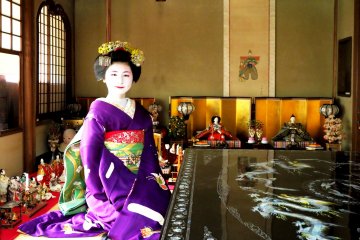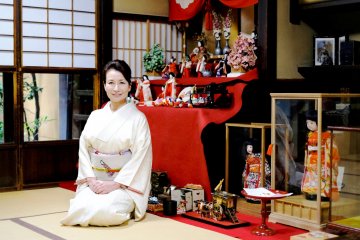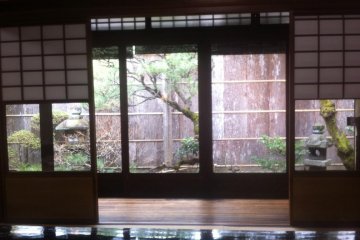In the 19th century the textile district in Nishijin, Kyoto blossomed. It was a time of hope, opulence and the opening up of Japan to the world. In the midst of this Tondaya, a textile warehouse, shop and family home was born. Today, the thirteenth owner, Ms Mineko Tanaka, have preserved the culture, design and architecture of that time in her beautiful home. It is not just a museum to the past, for it is a living and dynamic place, as the current descendants still live here, and English speaking guides and teachers enrich you with insights gained by participating in their intimate tea ceremonies, kimono dress ups and an educational tour of the Machiya. You can even have a Japanese style lunch or wedding. When I visited there was a display of wedding gifts offered at the owner’s daughter’s wedding the week before.
The original owners took great lengths to both design and build this merchant house. I can only imagine the search taken to source the ten meter long logs from the mountains, which are lined, uncut, in the corridors. It is tastefully decorated with exquisite antique furniture, such as the kimono chests (tansu) as well as old power switches from nearly a century ago, a rarity in any part of the world. I found a lot of inspiration for decorating my own home and garden.
Tondaya is typical of the many Machiya that was built at that time, with a narrow frontage (ostensibly to save property tax), and a number of courtyard gardens bringing both light and climate control for the various rooms. There are a number of wells that access the famous Kyoto spring water used both for cleansing as well as the making of tea.
I can’t think of a better way to experience Chado, the way of tea, than in Tondaya. Stepping into this hundred year old Kyoto Machiya is like stepping into the life of a merchant from the Meiji period. The design of the tea room reflects traditional design, with 4 tatami mats placed around a square center mat which acts as a table. Even the way you step in the room has its own unique rhythm. The host enters with her right foot, and leave with her left foot, like a precise dance.
While the tea ceremony may seem a bit expensive, it is well worth it. Entry also includes a guided tour of the Machiya. Joanna tells me that tradition dictates that Noh stages are undecorated, save a painting of a pine tree. The original owner takes this further by making a pine tree in the courtyard garden, the backdrop to the entertainment area. The area in front of the dining table can be used as a Noh stage, with a special tatami that makes a unique stamping sound when the Noh actors step on it. This and the many other features and stories of this Machiya gave me a glimpse into the life of the wealthy silk merchant who would think nothing of hosting elaborate parties for up to forty people at this townhouse which formed both shop and home.
Today, you can book this place for a variety of experiences, from ikebana to a dinner with Maiko (junior Geisha) as well as kimono dress ups or a traditional Japanese wedding.











